
| - |
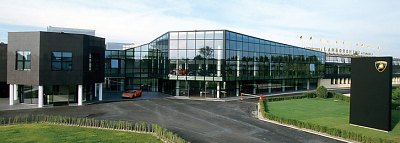
2022: 9233 units (5367 Urus, 3113 Huracan, 753 Aventador)
2021: 8405 units (5021 Urus, 2586 Huracan, 798 Aventador)
2020: 7430 units (4391 Urus, 2193 Huracan, 846 Aventador)
2019: 8205 units (4962 Urus, 2139 Huracan, 1104 Aventador)
2018: 5750 units (2780 Huracan, 1209 Aventador, 1761 Urus)
2017: 3815 units (2642 Huracan, 1173 Aventador)
2016: 3457 units (2353 Huracan, 1104 Aventador)
2015: 3245 units (2242 Huracan, 1003 Aventador)
2014: 2530 units (Production: 1540 Huracan, 1110 Aventador)
2013: 2121 units (Production: 76 Huracan, 933 Gallardo, 1113 Aventador)
2012: 2083 units (Production: 1221 Gallardo, 976 Aventador)
2011: 1602 units (Production: 1264 Gallardo, 447 Aventador)
2010: 1302 units (Production: 1064 Gallardo, 163 Murcielago)
2009: 1417 units (Production: 922 Gallardo, 331 Murcielago)
2008: 2430 units
2007: 2420 units (Production: 1951 Gallardo, 629 Murcielago)
2006: 2087 units (Production: 1651 Gallardo, 444 Murcielago)
2005: 1493 units (Production: 972 Gallardo, 464 Murcielago)
2004: 1592 units (1215 Gallardo and 377 Murcielago)
2003: 1305 units (890 Gallardo and 415 Murcielago)
2002: 442 units (all Murcielago)
2001: 297 units (Diablo plus a few Murcielago)
Financial instability used to limit the success of Lamborghini. However, since acquired by Audi in 1998, it has been growing stronger and stronger. Thanks to Audi's quality standard, new generation of Lamborghinis no longer suffer quality problems like their predecessors. The cars are also made easier to live with. The addition of the smaller Gallardo allowed Lamborghini to target at a volume in excess of 2000 units, which brought financial stability to Sant'Agata for the first time.
He always had much respect for Enzo Ferrari and considered Ferraris as the only cars he was competing with. However, it is said (and himself does not really deny it) that he had trouble with his Ferrari 250GT and complained to Maranello personally. Having not been received with the respect he expected, he decided to build his own GT car, a car that would be better than his Ferrari, of course.
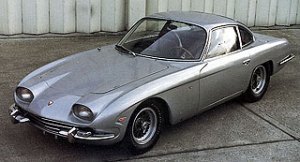 350GT (1964)
350GT (1964)Lamborghini was highly motivated. He poured countless money into his new purpose-built factory which was just 15km away from Maranello. He employed some ingenious people to design his cars, such as Giotto Bizzarrini (who had designed Ferrari 250GTO), Giampaolo Dallara (chassis designer), Paolo Stanzani (engineer), Bob Wallace (test driver) and Franco Scaglione (designer). With these people and sufficient funding, the first car, 350GTV, debut in 1963 Turin motor show and immediately became the star of the show. It featured an aluminum bodywork and an all-alloy V12 with 4 camshafts, more advanced than any contemporary Ferraris. The production version, 350GT and 400GT, shocked Ferrari for its high-level of finish and driving refinement. Lamborghini made a perfect launch.
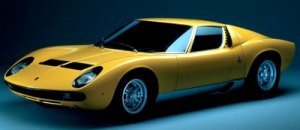 Miura (1966)
Miura (1966)However, that was nothing compare with the second car, Miura. This was seen as the world's first "supercar", which combined exotic looks (by Marcello Gandini of Bertone) and spectacular mechanical design - low center of gravity, mid-engined and V12 power. Thanks to its looks, many people really believed its wild claim of 300 km/h (186 mph) top speed ! The Miura was the dream car of every boys in the 1960s and the toys of millionaire playboys.
The empire of Ferruccio continued to grow with the addition of Espada 4-seater and entry-level Urraco. 1974 saw the an even more spectacular successor to Miura, the Countach. Its space-age appearance (again by Gandini), noise and power became a trademark of Lamborghini in the next 25 years.
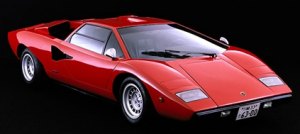 Countach (1974-89)
Countach (1974-89)When Lamborghini's prospect seemed to be promising, it was actually suffering from continuous loss, because of the extreme cost for such high-tech machines and the oil crisis further increased the difficulty for selling supercars. Ferruccio Lamborghini finally sold the company in 1972 and production was stopped for 2 years as a result. Since then the ownership of Lamborghini changed hands many times. Financial instability limited its development. The aging Countach kept soldiering on, although updated to keep up with new generations Ferrari.
The financial difficulty was finally resolved when Chrysler took over Lamborghini in 1987. A lot of money was put into the development of Diablo, which made it better developed than any previous models. Besides, an unknown amount of investment was made to the Formula 1 engine program, which saw some promising signs but finally ended when Chrysler pulled out.
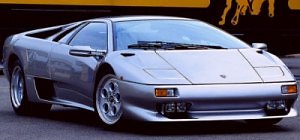 Diablo (1990)
Diablo (1990)The US giant car maker sold Lamborghini to Indonesian company Megatech in 1994. Not long later, it was transferred to Malaysian company Mycom Setdco and Indonesian company V'Power. Sant'Agata enjoyed a brief management stability under ex-Lotus executive Mike Kimberly. However, the Asian economic crisis in 1997 washed out the wealth of its Indonesian and Malaysian owners. Lamborghini found itself short of money to develop its next generation supercar and its long overdued "baby Lambo" program.
When Lamborghini knocked on the door of Audi, it only wanted to ask for sourcing Audi V8 engine and Quattro drivetrain for its baby Lambo. Unexpectedly, Volkswagen group boss Ferdinand Piech was interested in the Italian marque, thus the negotiation resulted in Audi taking over Lamborghini in 1998. Since then Audi invested a lot of money to modernize the Sant'Agata factory and helped engineering the new Murcielago. Its high quality standards and testing procedures improved the new generation Lamborghinis a lot, making them far more reliable and user friendly than the past.
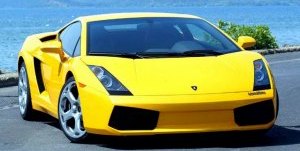 Gallardo (2003)
Gallardo (2003)The "baby Lambo" finally arrived in the form of Gallardo. It was engineered largely by Audi but, fortunately, preserved the traditional strengths of Lamborghini. Thanks to its success, Lamborghini's sales increased 8 folds from 2001 to 2007 ! It became the strongest challenger to Ferrari again.